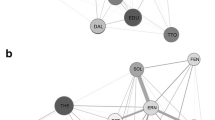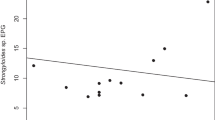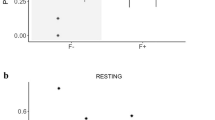Abstract
Animals can form groups for various reasons including safety from predators, access to potential mates and benefits of allo-parental care. However, there are costs associated with living in a group such as competition for food and/or mates with other members of the group, higher chances of disease transmission, etc. Group size dynamics can change with the biotic and abiotic environment around individuals. In the current study, we explored the links between group size dynamics and intestinal parasites of Indian peafowl (Pavo cristatus) in the context of seasons and food provisioning. Data for group size was collected across three seasons (pre-monsoon, monsoon and post-monsoon) at three field sites (Morachi Chincholi, Nashik and Rajasthan). Individual and group sightings of peafowl were noted down along with group size and composition (no. of males, females, adults, juveniles and sub-adults). Faecal samples were collected from food provision and non-provision areas across the same three seasons at same field sites. Parasite load in the samples was quantified using microscopic examination. Group size was significantly higher in pre-monsoon season as compared with monsoon and post-monsoon seasons. Monsoon and post-monsoon seasons had higher intestinal parasite prevalence and load as compared with pre-monsoon season. Thus, group size and intestinal parasites of Indian peafowl have an inverse relationship across seasons. Parasite load was significantly greater at food provision sites as compared with non-provision sites while parasite prevalence was comparable. Aggregation of individuals at the food provision sites may influence the parasite transmission and group-size dynamics in Indian peafowl. In conclusion, Indian peafowl are behaviourally plastic and fission-fusion of social groups may allow them to tackle ecological pressures such as predation and parasite transmission in different seasons.








Similar content being viewed by others
Availability of data and material
The data is made available as electronic supplementary material with this manuscript.
References
Atkinson CT, Thomas NJ, Hunter DB (2008) Parasitic Diseases of Wild Birds. Wiley-Blackwell, U.S.A
Aureli F, Schaffner CM, Boesch C, Bearder SK, Call J, Chapman CA, Connor R, Fiore A, Dunbar RIM (2008) Fission-fusion dynamics. Curr Anthropol 49:627–654. https://doi.org/10.1086/586708
Bhatt S, Khajuria JK, Katoch R, Dhama K (2014) Prevalence of endoparasites in Backyard poultry in North Indian Region: a performance based assessment study. Asian J Anim Vet Adv 9:479–488. https://doi.org/10.3923/ajava.2014.479.488
Beauchamp G (2010) Relationship between distance to cover, vigilance and group size in staging flocks of semipalmated sandpipers. J Ethol 116:645–652. https://doi.org/10.1111/j.1439-0310.2010.01778.x
Burton M, Burton R (2002) International Wildlife Encyclopedia. Marshall Cavendish, New York
D Caillaud F Levrero R Cristescu S Gatti M Dewas M Douadi A Gautier-Hion M Raymond N Meynard 2006 Gorilla susceptibility to Ebola virus: The cost of sociality Curr Biol Magazine R 489 https://doi.org/10.1016/j.cub.2006.06.017
Clark CW, Mangel M (1986) The evolutionary advantages of group foraging. Theor Popul Biol 30:45–47. https://doi.org/10.1016/0040-5809(86)90024-9
Clutton-Brock TH, Parker GA (1995) Sexual coercion in animal societies. Anim Behav 49:1345–1365. https://doi.org/10.1006/anbe.1995.0166
Couzin ID (2006) Behavioral ecology: social organization in fission–fusion societies. Curr Biol R169-R171. https://doi.org/10.1016/j.cub.2006.02.042
Cresswell W (1994) Flocking is an effective anti-predation strategy in redshanks, Tringa totanus. Anim Behav 47:433–442. https://doi.org/10.1006/anbe.1994.1057
Croft DP, Krause J, James R (2004) Social networks in the guppy (Poecilia reticulata). Proc R Soc B 271:516–519. https://doi.org/10.1098/rsbl.2004.0206
Cross PC, Edwards WH, Scurlock BM, Maichak EJ, Rogerson JD (2007) Effects of management and climate on elk brucellosis in the Greater Yellowstone Ecosystem. Ecol Appl 17:957–964. https://doi.org/10.1890/06-1603
Dusyzanski D, Wilber PG (1997) A guideline for the preparation of species descriptions in the Eimeriidae. J Parasitol 83:333–336. https://doi.org/10.2307/3284470
FishlockV LPC (2013) Forest elephants: fission–fusion and social arenas. Anim Behav 85:357–363. https://doi.org/10.1016/j.anbehav.2012.11.004
Fleischer RC (1983) Relationships between tidal oscillations and Ruddy Turnstone flocking, foraging and vigilance behaviour. Condor 85:22–29. https://doi.org/10.2307/1367881
Foster WA, Treherne JE (1981) Evidence for the dilution effect in the selfish herd from fish predation on a marine insect. Nature 293:466–467. https://doi.org/10.1038/293466a0
Freeland WJ (1979) Primate social groups as biological islands. Ecology 60:719–728. https://doi.org/10.2307/1936609
Gompper ME, Wright AN (2005) Altered prevalence of raccoon roundworm (Baylisascaris procyonis) owing to manipulated contact rates of hosts. J Zool 266:215–219. https://doi.org/10.1017/S0952836905006813
Gunn A, Pitt SJ (2012) Parasitology an integrated approach. Wiley-Blackwell, UK
Hochberg M (1991) Viruses as costs to gregarious feeding behaviour in the Lepidoptera. Oikos 61:291–296. https://doi.org/10.2307/3545236
Inger R, Bearhop S, Robinson JA, Ruxton G (2006) Prey choice affects the trade-off balance between predation and starvation in an avian herbivore. Anim Behav 71:1335–1341. https://doi.org/10.1016/j.anbehav.2005.08.015
Jaiswal AK, Sudan V, Shanker D, Kumar P (2013) Endoparasitic infections in Indian peacocks (Pavo cristatus) of Veterinary College Campus, Mathura. J Parasit Disease 37:26–28. https://doi.org/10.1007/s12639-012-0124-1
Jessop TS, Smissen P, Scheelings F, Dempster T (2012) Demographic and phenotypic effects of human mediated trophic subsidy on a large Australian lizard (Varanus varius): meal ticket or last supper? PLoS One 7:1–8. https://doi.org/10.1371/journal.pone.0034069
Kashima K, Ohtsuki H, Satake A (2013) Fission-fusion bat behaviour as a strategy for balancing the conflicting needs of maximizing information accuracy and minimizing infection risk. J Theor Biol 318:101–109. https://doi.org/10.1016/j.jtbi.2012.10.034
Knapp CR, Hines KN, Zachariah TT, Perez-Heydrich C, Iverson JB, Buckner SD, Halach SC, Lattin CR, Romero ML (2013) Physiological effects of tourism and associated food provisioning in an endangered iguana. Conserv Physiol 1:1–12. https://doi.org/10.1093/conphys/cot032
Krause J, Ruxton GD (2002) Living in groups. Oxford University Press, New York
Lehmann J, Boesch C (2004) To fission or to fusion: effects of community size on wild chimpanzee (Pan troglodytes verus) social organisation. Behav Ecol Sociobiol 56:207–216. https://doi.org/10.1007/s00265-004-0781
Leung TLF, Koprivnikar J (2016) Nematode parasite diversity in birds: the role of host ecology, life history and migration. J Anim Ecol 85:1471–1480. https://doi.org/10.1111/1365-2656.12581
Lutz HL, Hochachka WM, Engel JI, Bell JA, Tkach VV, Bates JM, Hackett JS, Weckstein JD (2015) Parasite prevalence corresponds to host life history in a diverse assemblage of Afrotropical birds and Haemosporidian parasites. PLoS One 10:1–24. https://doi.org/10.1371/journal.pone.0121254
Nandini S, Keerthipriya P, Vidya TNC (2017) Seasonal variation in female Asian elephant social structure in Nagarhole-Bandipur, southern India. Anim Behav 134:135–145. https://doi.org/10.1016/j.anbehav.2017.10.012
Pandey VS, Ndao M, Kumar V (1994) Seasonal prevalence of gastrointestinal nematodes in communal land goats of from the highveld of Zimbabve. Vet Parasitol 51:241–248. https://doi.org/10.1016/0304-4017(94)90161-9
Paranjpe DA, Dange PM (2020) A tale of two species: human and peafowl interactions in human dominated landscape influence each other’s behaviour: Wild life near human habitation. Curr Sci 119: 670-679. https://doi.org/10.18520/cs/v119/i4/670-679
Popa-Lisseanu AG, Bontadina F, Mora O, IbÁñez C (2008) Highly structured fission–fusion societies in an aerial-hawking, carnivorous bat. Anim Behav 75:471–482. https://doi.org/10.1016/j.anbehav.2007.05.011
Powell G (1974) Experimental analysis of the social value of flocking by starlings (Sturnus vulgaris) in relation to predation and foraging. Anim Behav 22:501–505. https://doi.org/10.1016/S0003-3472(74)80049-7
Pulliam HR (1973) On the advantages of flocking. J Theor Biol 38:419–422. https://doi.org/10.1016/0022-5193(73)90184-7
Rand MRW, Ridley MW, Lelliot AD (1984) The social organization of feral Indian peafowl. Anim Behav 32:830–835. https://doi.org/10.1016/S0003-3472(84)80159-1
Rimbach R, Bisanzio D, Galvis N, Link A, Di Fore A, Gillespie TR (2015) Brown spider monkeys (Ateles hybridus): a model for differentiating the role of social networks and physical contact on parasite transmission dynamics. Phil Trans R Soc B 370:1–10. https://doi.org/10.1098/rstb.2014.0110
Robb GN, McDonald RA, Chamberlain DE, Bearhop S (2008) Food for thought: supplementary feeding as a driver of ecological change in avian populations. Front Ecol Environ 6:476–484. https://doi.org/10.1890/060152
Sah P, Mann J, Bansal S (2017) Disease implications of animal social network structure: a synthesis across social systems. J Anim Ecol 87:546–558. https://doi.org/10.1111/1365-2656
Schoener ER, Howe L, Castro I, Alley MR (2012) Helminths in endemic, native and introduced passerines in New Zealand. N Z J Zool 39:245–256. https://doi.org/10.1080/03014223.2012.676992
Silk JB (2007) The adaptive value of sociality in mammalian groups. Phil Trans Biol Sci 362:539–559. https://doi.org/10.1098/rstb.2006.1994
Silk MJ, Croft DP, Trgenza T, Bearhop S (2014) The importance of fission–fusion social group dynamics in birds. Ibis 156:701–715. https://doi.org/10.1111/ibi.12191
Smith H, Frère C, Kobryn H, Bejder L (2016) Dolphin sociality, distribution and calving as important behavioural patterns informing management. Anim Conserv 19:462–471. https://doi.org/10.1111/acv.12263
Snore DA (1939) Differentiation of eggs of various genera of Nematodes parasitic in domestic ruminants in the United States. USDA, Washington, D.C, U.S.A
Sutton N (2019) Effects of food limitation on social grouping and foraging in a fission-fusion species. Dissertation, University of Cantebury
van Schaik CP (1999) The socioecology of fission-fusion sociality in Orangutans. Primates 40:69–86. https://doi.org/10.1007/BF02557703
Watve MG, Sukumar R (1992) Parasite abundance and diversity in mammals: correlates with host ecology. Proc Natl Acad Sci U.S.A. 92:8945–8949. https://doi.org/10.1073/pnas.92.19.8945
Wittemeyer G, Douglas-Hamilton I, Getz WM (2005) The socioecology of elephants: analysis of the processes creating multitiered social structures. Anim Behav 69:1357–1371. https://doi.org/10.1016/j.anbehav.2004.08.018
Acknowledgements
Thanks to Maharashtra Education Society’s Abasaheb Garware College, Pune for hosting the Ramalingaswami Re-entry Fellowship to DAP and providing the infrastructure and administrative support. We are thankful to Late Mr. Biswaroop Raha for suggesting field sites in Nashik, Dr. Dharmendra Khandal and volunteers of Tiger Watch who extended support for field work in Rajasthan. Authors also appreciate the support and hospitality of Morachi Chincholi residents during field work. We are also thankful to Rupesh Gawade, Prasad Gond, Nishant Zazam, Vishal Varma, Apeksha Dharshetkar, Priyanka Bansode, Eshan Pahade, Ankita Divekar and Akash Dubey and Vedanti Mahimkar for helping with data collection on field. We want to thank the anonymous reviewers for their valuable suggestions which increased the quality of this manuscript.
Funding
This study was funded through Ramalingaswami Re-entry Fellowship to DAP by Department of Biotechnology, Government of India.
Author information
Authors and Affiliations
Contributions
DAP conceived the study, designed methodology, collected data and helped in manuscript preparation. PD designed the methodology, collected data, analysed the data and prepared the manuscript. PM collected and analysed the data.
Corresponding author
Ethics declarations
Ethics approval
No live animals/samples were handled during this study. The study was conducted outside protected areas. Therefore, the work did not require special permissions or approval.
Conflict of interests
The authors declare no competing interests.
Additional information
Publisher's Note
Springer Nature remains neutral with regard to jurisdictional claims in published maps and institutional affiliations.
Rights and permissions
About this article
Cite this article
Dange, P., Mhaisalkar, P. & Paranjpe, D. To group or not to group: group size dynamics and intestinal parasites in Indian peafowl populations. acta ethol 24, 107–117 (2021). https://doi.org/10.1007/s10211-021-00366-x
Received:
Revised:
Accepted:
Published:
Issue Date:
DOI: https://doi.org/10.1007/s10211-021-00366-x




